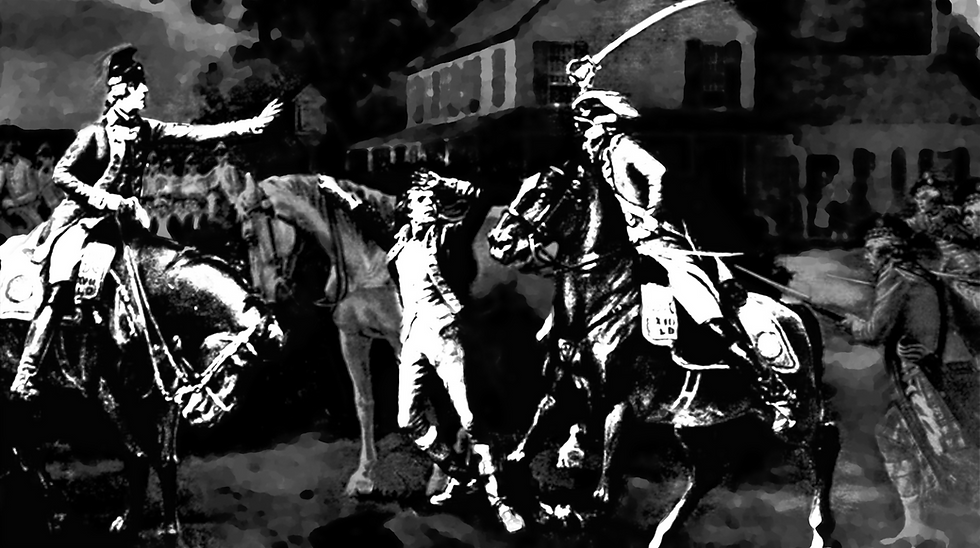Dress for the Job You Want
- 17th Regiment Light Dragoon
- May 14, 2023
- 4 min read
"A free people ought not only to be armed, but disciplined; to which end a uniform and well-digested plan is requisite..." - George Washington

Uniforms in any military are more than just pieces of clothing. They serve multiple purposes, both functional and symbolic, and there was no time in history when this was more apparent than in the 18th century. A regimental coat in the British and Continental Army was a versatile, and arguably the most important part of a soldier's daily dress. And the 17th was no exception.
Very few original examples of regimentals survived to our modern day. So we must rely on paintings and written descriptions of specifics, with an understanding of how and why they were generally constructed in order to replicate an accurate pattern. For our uses, there are many 19th-century artistic renderings of the 17th Dragoons but many were done with the all-too-typical Victorian "panache" for romanticism over accurate detail.

The truth about regimentals is that they
were a decorated, utilitarian piece of a soldier's kit. The wool shell lined with linen allowed the coat to be warm in the winter, and wicking in the summer heat. The colors helped soldiers and officers to discern friend from foe amidst the heavy smoke in battle. the facings and lace help identify at a distance the type of unit and the specific regiment at a glance, and even the buttons are cast to specify the wearer's affiliations.
For the 17th, we have the benefit of having primary and secondary documentation in written form as well as an invaluable portrait of an unknown dragoon officer painted in Philadelphia during the war.
This painting is in accordance with the description of the uniforms as they were worn by the 1760s, when King George III wrote the warrants. The Honorable John Fortescue recounts:
“Let us therefore begin with the men; and as we have already seen what manner of men they were, physically considered, let us first note how they were dressed. Strictly speaking, it was not until 1764 that the Light Dragoon regiments received their distinct dress regulations; but the alterations then made were so slight that we may fairly take the dress of 1764 as the dress of 1760.
To begin with, every man was supplied by the Colonel, by contract, with coat, waistcoat, breeches, and cloak. The coat, of course, was of scarlet, full and long in the skirt, but whether 1760. lapelled or not before 1763 it is difficult to say. Lapels meant a good deal in those days; the coats of Horse being lapelled to the skirt, those of Dragoon Guards lapelled to the waist, while those of Dragoons were double-breasted and had no lapels at all.
The Light Dragoons being a novelty, it is difficult to say how they were distinguished in this respect, but probably in 1760 (and certainly in 1763) their coats were lapelled to the to the waist with the colour of the regimental facing, the lapels being three inches broad, with plain white buttons disposed thereon in pairs.”
- Fortescue’s “A History of the 17th Lancers” 1895
As can be seen in the portrait, the lapels indeed have buttons placed in pairs. Note the button on the collar and the winged lappets prominently displayed above the collar, rather than tucked beneath it as with some unit's regimental designs. , which is a distinct version of the Regimental pattern, as some units' designs. The buttonholes on the officer's coat are adorned with silver trim and black bands, originally meant to signify mourning for the fallen hero of the Seven Years War, General Wolfe. His narrow epaulets are also silver, indicating he is probably a commissioned officer.
Unseen in the painting, we read in Fortescue's account that the lapels would have gone to the waist, and when finished are 3" wide. This is supported by Robert Hinde's 1778 publication, "The Discipline of the Light Horse" in which he details, under the heading Color of the Facings, and Lappels:
"The 17th, white with Half Lappels"
The indication is that a full lapel would have gone to the tails as with many military and civilian coats, and a half lapel, being half of the coat, would end at the waist. From there according to Fortescue, the coats were long in the tail, as opposed to being short like many light infantry units.
Therefore it can be safely assumed that we can put the matter of the winged lappetts and the size and length of the lapels to bed.
The tape in use for the facings of the button can be derived from the original warrants, which are also referenced in the Army Inspection Returns of the 25th of May, 1768 as follows:
"Officer's scarlet coat lapelled to the waist and turned up with white; silver lace with a black edge on the button-holes."
So while the normal everyday soldier would have simple white button-hole lace, the officers were distinguished with the black lining, symbolizing mourning for General Wolfe.
One of our next goals is to dig into the issue of the chevrons, as this is another aspect of the regimental construction that is a bit





Comments